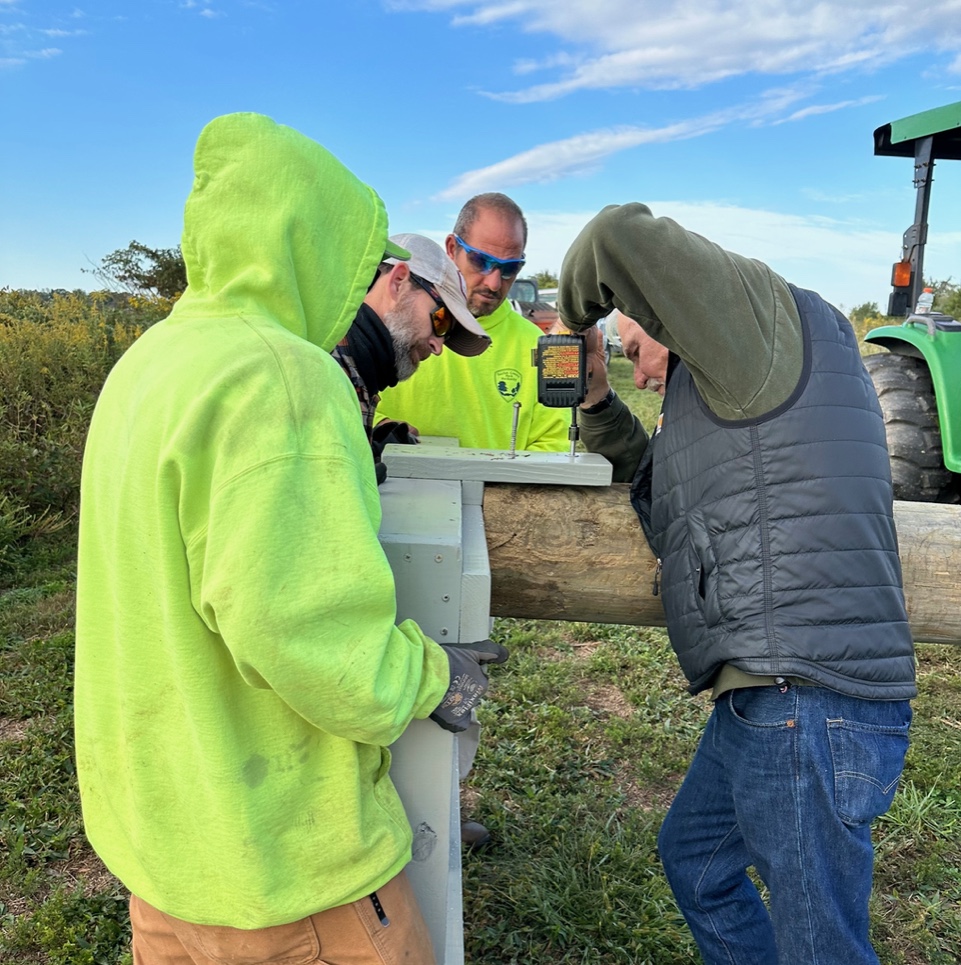A recycled 50-foot utility pole is moved to the site by maintenance operations employee Alex Guevara-Santos in advance of installation day
There are not nearly as many Ospreys in the Lorton area as in areas closer to the Chesapeake Bay. The birds are making a comeback here and across the U.S. after the impacts of pesticides crashed their numbers with poisoning and thinned eggshells. In 2007, there were estimated to be 16,000 to 19,000 breeding pairs across the country; up from only 3,500 pairs in the 1950’s. And, thanks to an accommodating Fairfax County Park Authority, their Area 4 Maintenance Operations crew, and a small group of park volunteers, one more new home has been raised to attract  additional breeding Osprey pairs to Lorton’s Laurel Hill Park.
additional breeding Osprey pairs to Lorton’s Laurel Hill Park.
Area 4 managers championed the idea of providing a nest platform for a while without finding a group willing to take on the effort. Then, earlier this year, the Laurel Hill Park’s own volunteer team agreed to take on the project as a joint effort, with installation assistance. Modifying a design recommended by Cornell Lab of Ornithology, to add a roosting perch, William Beletsky, of Springfield, constructed the platform structure. Other volunteers helped to salvage materials, scouted a likely spot, and sought out required Park Authority approvals.
The greatest hurdle for the project volunteers was finding a support pole substantial enough to support the weight of the 40-by-40 inch platform, and long enough to place the platform at a height preferred by ospreys. When a recycled 50-foot utility pole became available, the team’s problem was solved.
The challenge shifted to the installation crew to use available equipment to dig the six foot hole and raise the long pole, with the platform pre-attached. No bucket equipment was available. A mechanical auger attached to loader equipment quickly dug the hole to the depth required to give ample foundation. Safety guide ropes were attached to the pole; one providing part of the lift. A tractor fitted with a forklift, and with an assist from the loading machine for stability, maneuvered the pole slowly and gently, coaxing it up and into the hole, earning a cheer from watching crew and volunteers. A climbing guard to ward off predators will be added.
 A recycled 50-foot utility pole is moved to the site by maintenance operations employee Alex Guevara-Santos in advance of installation day
A recycled 50-foot utility pole is moved to the site by maintenance operations employee Alex Guevara-Santos in advance of installation day
Ospreys, which are not as maneuverable as other hawks, need nest sites in open areas for an easy approach, which have a sturdy base, and are not susceptible to raids by ground predators such as raccoons and snakes. Also called, “fish hawks” for their preferred diet, they need to be near water. They typically build their nests on snags, high trees, and on human built platforms, such as channel markers, light posts and utility poles. Their nests are built with sticks, lined with grasses, vines, sod, and sometimes plastic debris which can prove hazardous to the birds and their chicks.
The male collects the materials and the female arranges it. In the first years, the nest is relatively small, but the pair usually returns to the same nest year after year, adding to the nest size, which can reach a diameter of three to six feet and a considerable depth, up to 13 feet. They raise only one brood per season, with one to four eggs.
The large raptors, a species of hawk, have a wingspan of about four feet, but weigh only three to four pounds. They are often mistaken for their similarly white-headed, larger cousin, the Bald Eagle, which has a larger wingspan of up to 8.5 feet, and weighs 6 to 14 pounds.
Two nearby osprey nests, one on the former Nike site, and one in Occoquan Regional Park, have produced chicks in multiple seasons. Those birds, parents and juveniles, departed in September on their southern migration to South America or the Caribbean. Volunteers must await the return of the parents and prior years' juveniles in the Spring, usually early March, to see if a pair will take up residence on the new platform. An added unknown is whether the juvenile female rescued in July in Lorton from plastic line entanglement and released in the Shenandoah river valley (see Connection, July 27, and August 19) will return to our area this Spring or next, or will choose a mate, and return to the Shenandoah establishing her own new family there.
Volunteers expect to train binoculars on the nest regularly in the Spring. The nest platform’s location, just off the loop trail at the Central Green, will make it easy for all park users to join the Osprey watch.
